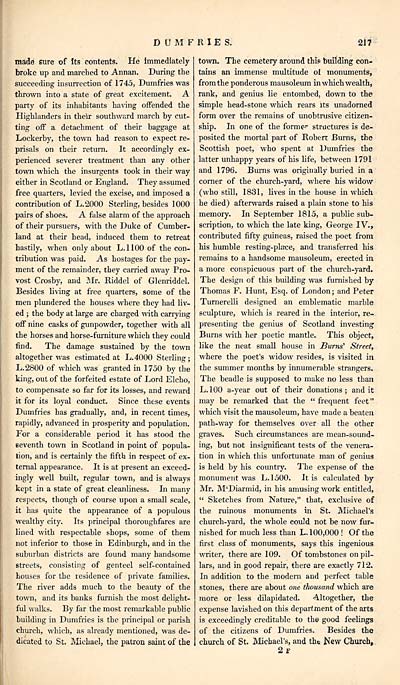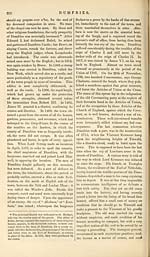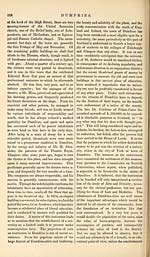Gazetteer of Scotland > Volume 1
(247) Page 217 - DUM
Download files
Complete book:
Individual page:
Thumbnail gallery: Grid view | List view

DUMFRIES.
217
made sure of Its contents. He immediately
broke up and marched to Annan. During the
succeeding insurrection of 1745, Dumfries was
thrown into a state of great excitement. A
party of its inhabitants having offended the
Highlanders in their southward march by cut-
ting off a detachment of their baggage at
Lockerby, the town had reason to expect re-
prisals on their return. It accordingly ex-
perienced severer treatment than any other
town which the insurgents took in their way
either in Scotland or England. They assumed
free quarters, levied the excise, and imposed a
contribution of L.2000 Sterling, besides 1000
pairs of shoes. A false alarm of the approach
of their pursuers, with the Duke of Cumber-
land at their head, induced them to retreat
hastily, when only about L.1100 of the con-
tribution was paid. As hostages for the pay-
ment of the remainder, they carried away Pro-
vost Crosby, and Mr. Riddel of Glenriddel.
Besides living at free quarters, some of the
men plundered the houses where they had liv-
ed ; the body at large are charged with carrying
off nine casks of gunpowder, together with all
the horses and horse-furniture which they could
find. The damage sustained by the town
altogether was estimated at L.4000 Sterling ;
L.2800 of which was granted in 1750 by the
king, out of the forfeited estate of Lord Elcho,
to compensate so far for its losses, and reward
it for its loyal conduct. Since these events
Dumfries has gradually, and, in recent times,
rapidly, advanced in prosperity and population.
For a considerable period it has stood the
seventh town in Scotland in point of popula-
tion, and is certainly the fifth in respect of ex-
ternal appearance. It is at present an exceed-
ingly well built, regular town, and is always
kept in a state of great cleanliness. In many
respects, though of course upon a small scale,
it has quite the appearance of a populous
wealthy city. Its principal thoroughfares are
lined with respectable shops, some of them
not inferior to those in Edinburgh, and in the
suburban districts are found many handsome
streets, consisting of genteel self-contained
houses for the residence of private families.
The river adds much to the beauty of the
town, and its banks furnish the most delight-
ful walks. By far the most remarkable public
building in Dumfries is the principal or parish
church, which, as already mentioned, was de-
dicated to St. Michael, the patron saint of the
town. The cemetery around this building con-
tains an immense multitude ol monuments,
from the ponderous mausoleum in which wealth,
rank, and genius lie entombed, down to the
simple head-stone which rears its unadorned
form over the remains of unobtrusive citizen-
ship. In one of the former structures is de-
posited the mortal part of Robert Burns, the
Scottish poet, who spent at Dumfries the
latter unhappy years of his life, between 1791
and 1796. Burns was originally buried in a
corner of the church-yard, where his widow
(who still, 1831, lives in the house in which
he died) afterwards raised a plain stone to his
memory. In September 1815, a public sub-
scription, to which the late king, George IV.,
contributed fifty guineas, raised the poet from
his humble resting-place, and transferred his
remains to a handsome mausoleum, erected in
a more conspicuous part of the church-yard.
The design of this building was furnished by
Thomas F. Hunt, Esq. of London; and Peter
Tumerelli designed an emblematic marble
sculpture, which is reared in the interior, re-
presenting the genius of Scotland investing
Burns with her poetic mantle. This object,
like the neat small house in Sums' Street,
where the poet's widow resides, is visited in
the summer months by innumerable strangers.
The beadle is supposed to make no less than
L.100 a-year out of their donations; and it
may be remarked that the " frequent feet"
which visit the mausoleum, have made a beaten
path-way for themselves over all the other
graves. Such circumstances are mean-soiuid-
ing, but not insignificant tests of the venera-
tion in which this unfortunate man of genius
is held by his country. The expense of the
monument was L.1500. It is calculated by
Mr. M'Diarmid, in his amusing work entitled,
" Sketches from Nature," that, exclusive of
the ruinous monuments in St. Michael's
church-yard, the whole could not be now fur-
nished for much less than L. 100,000 ! Of the
first class of monuments, says this ingenious
writer, there are 109. Of tombstones on pil-
lars, and in good repair, there are exactly 712.
In addition to the modern and perfect table
stones, there are about one thousand which are
more or less dilapidated. Altogether, the
expense lavished on this department of the arts
is exceedingly creditable to the good feelings
of the citizens of Dumfries. Besides the
church of St. Michael's, and the New Church,
2f
217
made sure of Its contents. He immediately
broke up and marched to Annan. During the
succeeding insurrection of 1745, Dumfries was
thrown into a state of great excitement. A
party of its inhabitants having offended the
Highlanders in their southward march by cut-
ting off a detachment of their baggage at
Lockerby, the town had reason to expect re-
prisals on their return. It accordingly ex-
perienced severer treatment than any other
town which the insurgents took in their way
either in Scotland or England. They assumed
free quarters, levied the excise, and imposed a
contribution of L.2000 Sterling, besides 1000
pairs of shoes. A false alarm of the approach
of their pursuers, with the Duke of Cumber-
land at their head, induced them to retreat
hastily, when only about L.1100 of the con-
tribution was paid. As hostages for the pay-
ment of the remainder, they carried away Pro-
vost Crosby, and Mr. Riddel of Glenriddel.
Besides living at free quarters, some of the
men plundered the houses where they had liv-
ed ; the body at large are charged with carrying
off nine casks of gunpowder, together with all
the horses and horse-furniture which they could
find. The damage sustained by the town
altogether was estimated at L.4000 Sterling ;
L.2800 of which was granted in 1750 by the
king, out of the forfeited estate of Lord Elcho,
to compensate so far for its losses, and reward
it for its loyal conduct. Since these events
Dumfries has gradually, and, in recent times,
rapidly, advanced in prosperity and population.
For a considerable period it has stood the
seventh town in Scotland in point of popula-
tion, and is certainly the fifth in respect of ex-
ternal appearance. It is at present an exceed-
ingly well built, regular town, and is always
kept in a state of great cleanliness. In many
respects, though of course upon a small scale,
it has quite the appearance of a populous
wealthy city. Its principal thoroughfares are
lined with respectable shops, some of them
not inferior to those in Edinburgh, and in the
suburban districts are found many handsome
streets, consisting of genteel self-contained
houses for the residence of private families.
The river adds much to the beauty of the
town, and its banks furnish the most delight-
ful walks. By far the most remarkable public
building in Dumfries is the principal or parish
church, which, as already mentioned, was de-
dicated to St. Michael, the patron saint of the
town. The cemetery around this building con-
tains an immense multitude ol monuments,
from the ponderous mausoleum in which wealth,
rank, and genius lie entombed, down to the
simple head-stone which rears its unadorned
form over the remains of unobtrusive citizen-
ship. In one of the former structures is de-
posited the mortal part of Robert Burns, the
Scottish poet, who spent at Dumfries the
latter unhappy years of his life, between 1791
and 1796. Burns was originally buried in a
corner of the church-yard, where his widow
(who still, 1831, lives in the house in which
he died) afterwards raised a plain stone to his
memory. In September 1815, a public sub-
scription, to which the late king, George IV.,
contributed fifty guineas, raised the poet from
his humble resting-place, and transferred his
remains to a handsome mausoleum, erected in
a more conspicuous part of the church-yard.
The design of this building was furnished by
Thomas F. Hunt, Esq. of London; and Peter
Tumerelli designed an emblematic marble
sculpture, which is reared in the interior, re-
presenting the genius of Scotland investing
Burns with her poetic mantle. This object,
like the neat small house in Sums' Street,
where the poet's widow resides, is visited in
the summer months by innumerable strangers.
The beadle is supposed to make no less than
L.100 a-year out of their donations; and it
may be remarked that the " frequent feet"
which visit the mausoleum, have made a beaten
path-way for themselves over all the other
graves. Such circumstances are mean-soiuid-
ing, but not insignificant tests of the venera-
tion in which this unfortunate man of genius
is held by his country. The expense of the
monument was L.1500. It is calculated by
Mr. M'Diarmid, in his amusing work entitled,
" Sketches from Nature," that, exclusive of
the ruinous monuments in St. Michael's
church-yard, the whole could not be now fur-
nished for much less than L. 100,000 ! Of the
first class of monuments, says this ingenious
writer, there are 109. Of tombstones on pil-
lars, and in good repair, there are exactly 712.
In addition to the modern and perfect table
stones, there are about one thousand which are
more or less dilapidated. Altogether, the
expense lavished on this department of the arts
is exceedingly creditable to the good feelings
of the citizens of Dumfries. Besides the
church of St. Michael's, and the New Church,
2f
Set display mode to: Large image | Transcription
Images and transcriptions on this page, including medium image downloads, may be used under the Creative Commons Attribution 4.0 International Licence unless otherwise stated. ![]()
| Gazetteers of Scotland, 1803-1901 > Gazetteer of Scotland > Volume 1 > (247) Page 217 - DUM |
|---|
| Permanent URL | https://digital.nls.uk/97427326 |
|---|
| Description | Volume I: Abbey to Glenartney. |
|---|---|
| Attribution and copyright: |
|
| Description | By Robert Chambers and William Chambers. Glasgow: Blackie & Son, 1838. 2 volumes. |
|---|---|
| Shelfmark | NF.1461.g.7 |
| Additional NLS resources: | |

